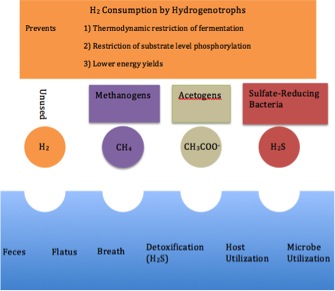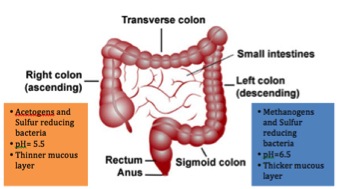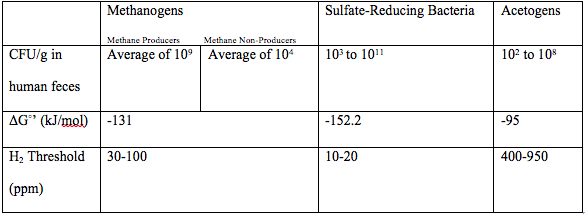Gut hydrogenotrophs
Introduction of Hydrogenotrophs and the large intestine
Dietary components that have not yet been absorbed or digested in the gastrointestinal tract can be salvaged in the colon (part of the large intestine). [1] Here, these exogenous components and endogenously produced substrates (such as mucin) are fermented by anaerobic gut microbiota. [2] Gut microbiota consist of fermentative bacteria and their symbiotic counterpart, the hydrogenotrophs. The more abundant fermentative bacteria produce predominantly short-chain fatty acids (SCFAs), H2 and CO2. As much as 10% of the host’s daily energy needs are obtained from SCFAs (such as butyrate) with between 95-99% absorbed and utilized. [3] Hydrogenotrophs are organisms that consume hydrogen as part of their metabolism and are integral for maintaining the normal functioning of the gut microbiota. [2]
In a process analogous to the way mammalian cells dispose of reducing power by reducing O2 to H2O, fermentative gut microbiota reduce hydrogen H+ to H2 to dispose of reducing power. [1] H2 formation occurs predominantly through the oxidation of pyruvate, formate or reduced NADH and FADH2.
Hydrogenotrophs, by consuming this H2, are in a syntrophic relationship with fermentative gut microbiota by lowering concentration of the products of fermentation. [2] High partial pressure of H2 thermodynamically restricts the fermentation process and also inhibits oxidation of NADH and FADH2, causing the key reactions of substrate level phosphorylation to reach equilibrium. As H2 builds, alternative mixed fermentation pathways produce electron rich products such as ethanol, lactate or succinate. These products have lower energy yields than SCFAs; thus H2 depletion enables more complete energy recovery from organic substrate breakdown. [4] Hydrogen gas that is not utilized by hydrogenotrophs is either absorbed into the circulation and exhaled with breath or is expelled as flatus (Figure 1). [1],[2]
Types of Hydrogenotrophs
There are three major types of hydrogenotrophs found in humans: methanogens, sulfate-reducing bacteria (SRB) and acetogens.
Methanogens
Methanogens are a clade of organisms unique to the domain Archaea and are named for their ability to oxidize hydrogen and reduce CO2 to produce CH4. [2] Populations of methanogens vary between humans. This variation is detectable by the presence (or lack thereof) of methane on breath and the amount of colony forming units (CFU) of methanogens in feces. Humans with detectable levels of methane on their breath are ‘methane-producers’ (with an average of 109 CFU/g of feces) [2] while those who do not are non-methane producers (with an average of 104 CFU/g of feces) (Figure 1). [5] Methane producers vary by ethnic group ranging from 34% to 87%. [5] The following chemical equation describes the reduction of hydrogen by these bacteria:
4H2+CO2 -> CH4+2H2O [1]
Not all methanogens are restricted to using CO2 as a substrate. Methylotrophic methanogens are capable of reducing other mono-carbon compounds such as methanol instead. [2]
Sulfate-reducing bacteria
Sulfate Reducing Bacteria (SRB) are obligate anaerobic bacteria that use sulfate as a terminal electron acceptor, undergoing dissimilatory sulfate reduction. [2] There are 5 dominant SRB genera in the large intestine; Desulfobacter, Desulomonas, Desulfotomaculum, Desulfovibrio and Desulobulbus, with the latter two accounting for most of the 103 to 1011 CFU/g H2 utilizing SRB in human feces. [1] The following chemical equation describes the utilization of hydrogen by SRB:
4H2+SO42- + H+-> HS-+4H2O [1]
This yields H2S as a final product. [1] H2S is highly toxic to humans and is either expelled as flatus, in feces [2] or detoxified to thiosulfate by colonic mucosa [6],[7] (Figure 1). It is important to note that not all SRB use H2 as an electron donor, some use SCFA’s, or lactate among others. [8] SRB Hydrogenotrophs make up only a small component of all colonic SRB. [2] [8]
Acetogens
Acetogens are obligate anaerobes that synthesize the high energy intermediate acetyl-CoA from CO2. [2] The density of acetogens found in human feces is 102 to 108 CFU/g. [2] The acetogens utilize H2 according to the following equation:
4H2+2CO2 -> CH3COO-+2H2O+H+ [1]
Acetate is the final product. Autotrophic (with H2 as the only electron donor) and heterotrophic growth (ex: with glucose as electron donor) are both possible. There is even evidence to suggest that mixotrophic growth, both types of growth happening together, increases H2-disposal rates of acetogens in the colon. [2]
Competition between Hydrogenotrophs
It is generally accepted that there is competition among methanogens, SRBs and acetogens for H2 substrate. [2] The most successful of these competitors are the SRBs, while acetogens compete least successfully of the three as displayed in abundant experiments. [1],[2] Two models support this theory; the thermodynamic model and the threshold model. The thermodynamic model is dictated by which bacteria oxidize H2 in the most thermodynamically favorable fashion. Oxidation of H2 by SRB (ΔG°’= -152.2 kJ/mol) is favored over methanogens (ΔG°’= -131 kJ/mol) and methanogens are thermodynamically much more advantaged by H2 utilization than acetogens (ΔG°’= -95 kJ/mol). [1] The threshold model further supports this finding – organisms with the highest substrate (H2) affinity and growth yield compete more successfully at lower concentrations of H2; this concentration is 10-20 ppm for SRB, 30-100 ppm for methanogens and 400-950ppm for acetogens. [2]
The generally accepted notion that it is direct competition that facilitates the most abundant hydrogentroph type may be an oversimplification; differing environments within the colon might also play a role. Acetogens and SRB are most abundant in the right colon (with a pH of 5.5) while the SRB and methanogens are most abundant in the left colon (with a pH of 6.5) (Figure 2). [2] This phenomenon may be explained by SRB and methanogens being optimally functional at neutral pH while acetogens are optimally functional at lower pH. [1]
Health Significance
The by-products of hydrogenotrophs have a wide range of effects on the human gut, with suspected relevance to Irritable Bowel Syndrome (IBS), Inflammatory Bowel Disease (IBD), Salmonella infection and more.
Methane may cause constipation in IBS by slowing intestinal transit in the small bowel and predisposing to constipation. [9] High levels of secreted methane have been found to correlate with decreased levels of serotonin -a regulator of peristalsis in the gastrointestinal tract. [2]
IBD is a chronic inflammatory group of gastrointestinal conditions with both genetic and environmental associations, including ulcerative colitis (UC), in which colonic intestinal mucosa is affected and Crohn’s disease (CD) in which any segment of the gastrointestinal tract is affected.
[2],[10] H2S has been shown to strongly inhibit colon motor patterns. This happens when colonic mucosa is broken down such as in ulcerative colitis. [7] The SRB density has been shown to be higher in UC patients; H2S levels have been found to be 3-4 times higher in patients with UC. [1] [2] [10] In both types of IBD an increase in endogenous sulfates (from enzymes breaking down sulfated mucins) and exogenous sulfate (from dietary intake-more protein means more sulfur amino acids and thus more sulfate) pose a risk to the genetically predisposed. [2] Methane levels also provide insight into IBD; multiple studies provide strong evidence that breath methane is often not detected in IBD patients. [2]
A recent understanding of Salmonella’s adaptation for effective competition with gut microbiota relates to H2S by the ability to utilize tetrathionate as an electron acceptor. [6] Harmful H2S is converted to thiosulfate by colonic mucosa to prevent damage. Respiratory bursts in blood leukocytes during inflammation results in production of tetrathionate from thiosulfate. [6] Salmonella uses tetrathionate as a respiratory electron acceptor and is thus able to outcompete gut microbiota. [6]
Future Research
Concentrations of gases in breath, flatus and feces may be a poor indicator for actual hydrogenotroph composition in the colon. Further development of methodologies for studying mixed communities in vivo by isotopic tracers and molecular sequencing would be beneficial. [11] As displayed by the different pH levels in the right and left colon, location makes a difference in the composition of hydrogenotrophs and thus further in situ research could establish a more concrete understanding. Therapeutic opportunity is just beginning with the advent of fecal microbiota transplantation for certain colon related diseases. [12] With greater understanding of microbiota composition in the colon, insight will be gained into the development and maintenance of colon diseases such as Inflammatory Bowel Disease, Irritable bowel syndrome and possibly colon cancer. [2]
References
(1) Gibson, G.R. et al. 1993. “Sulphate reducing bacteria and hydrogen metabolism in the human large intestine.” Gut 34, 437–439.
(2) Nakamura, N., Lin, H. C., McSweeney, C. S., Mackie, R. I. & Gaskins,H. R. 2010. “Mechanisms of microbial hydrogen disposal in the human colon and implications for health and disease.” Annu Rev FoodSci Technol 1, 363–395.
(3) Macfarlane GT, Gibson GR. 1997. “Carbohydrate fermentation, energy transduction and gas metabolism in the human large intestine.” In Gastrointestinal Microbiology, ed. RI Mackie, BA White, 1:269–318.New York: Chapman & Hall.
(4) Gibson GR, Cummings JH, Macfarlane GT, Allison C, Segal I, et al. 1990. “Alternative pathways for hydrogen disposal during fermentation in the human colon.” Gut 31:679–83.
(5) Levitt MD, Furne JK, Kuskowski M, Ruddy J. 2006. “Stability of human methanogenic flora over 35 years and a review of insights obtained from breath methane measurements.” Clin. Gastroenterol. Hepatol. 4:123–29.
(6) Winter, S. E. et al. 2010. “Gut inflammation provides a respiratory electron acceptor for Salmonella.” Nature 467, 426–429.
(7) Gallego D, Clave P, Donovan J, Rahmati R, Grundy D, et al. 2008. “The gaseous mediator, hydrogen sulphide, inhibits in vitro motor patterns in the human, rat and mouse colon and jejunum.” Neurogastroenterol. Motil.20:1306–16.
(8) Gibson GR, Macfarlane GT, Cummings JH. 1988c. “Occurrence of sulphate-reducing bacteria in human faeces and the relationship of dissimilatory sulphate reduction to methanogenesis in the large gut.” J. Appl.Bacteriol. 65:103–11.
(9) Pimentel M, Lin HC, Enayati P et al. 2006. “Methane, a gas produced by enteric bacteria, slows intestinal transit and augments small intestinal contractile activity.” Am J Physiol 290: 61089–95.
(10) Gibson GR, Cummings JH, Macfarlane GT. 1991. “Growth and activities of sulphate-reducing bacteria in gut contents of healthy subjects and patients with ulcerative colitis.” FEMS Microbiol. Ecol. 86:103-112.
(11) Duncan, S.H., Louis, P., and Flint, H.J. 2007a. “Cultivable bacterial diversity from the human colon.” Lett Appl Microbiol 44: 343–350.
(12) Borody, T.J., Campbell, J. 2011. “Fecal microbiota transplantation: current status and future directions.” Expert Rev. Gastroenterol. Hepatol. 5(6), 653-655.



